A Simplified Methodology for Existing Tertiary Buildings’ Cooling Energy Need Estimation at District Level: A Feasibility Study of a District Cooling System in Marrakech
Abstract
:1. Introduction
1.1. Estimation of Energy Needs for Cooling
1.2. Cooling Need and Electricity Consumption in Tertiary Buildings
2. Methodology
2.1. Simplified Method for Estimating Annual Cooling Energy Need of Existing Tertiary Buildings
- electricity bills
- cooling season length
- conditioned area
- cooling system efficiency
2.2. Extended Degree-Hours Method for Hourly Energy Demand Profile Prediction at District Level
- External heat gains , which includes the heat gain through the building envelope, and gains due to the infiltration and ventilation of external air.
- Internal heat gains , which includes heat gains due to internal sources such as lighting, equipment, and occupants.
3. Case Study Description
Selected Area for DC Network Implementation
4. Results
District Cooling Demand and Profile Estimation
5. Preliminary Design and Evaluation Framework for DC Planning
5.1. Preliminary Design of DC
5.2. Economic and Environmental Evaluations.
- all costs regarding the cooling plant such as building construction, chillers, cooling towers, and controls,
- distribution systems such as excavation, backfill, piping, pumps, and valves,
- thermal energy storage (TES),
- substations, and
- other costs such as cost of land, design, etc.
- Operation and maintenance (O&M) such as maintenance, repairing and replacing the components, labour for operation, etc.,
- energy and power charge costs,
- water consumption costs,
- rent, and
- other costs such as administrative costs, insurance, etc.
6. Discussion and Conclusions
Author Contributions
Funding
Conflicts of Interest
Nomenclature
| Annual cooling energy need | IRR | Internal rate of return | |
| CAPEX | Capital expenditures | NPV | Net present value |
| CF | Cash flow | O&M | Operation and maintenance |
| CFCs | Chlorofluorocarbons | OPEX | Operational expenditures |
| COP | Coefficient of performance | Outdoor air temperature | |
| CDD | Cooling degree days | PBT | Payback time |
| Cooling system efficiency | r | Real discount rate | |
| DC | District cooling | RES | Renewable energy sources |
| DCS | District cooling system | RoI | Return on investment |
| DHW | Domestic hot water | Sol–air temperature | |
| EFLH | Equivalent full-load hours | Rad | Solar radiation |
| ECI | European cooling index | ho | Surface convective and radiative heat transfer coefficient |
| Global solar irradiance on surface | TES | Thermal energy storage | |
| HDD | Heating degree days | TRNSYS | Transient system simulation tool |
| HDPE | High-density Polyurethane | USD | United States Dollar |
| HFCs | Hydrofluorocarbons | VAT | Value-added tax |
Appendix A
| Item | Price | Unit | Note | |
|---|---|---|---|---|
| DC system | Generation plant | 600,000 | USD/MW | The price includes all costs related to and located in DC generation plant such as design, building construction, chillers, refrigerant, cooling towers, primary and secondary pumps, control system, electrical transformers, and water supply equipment for cooling towers. |
| Distribution | 300 | USD/m | Per meter of pipe. The price includes excavation, backfill, surface restoration, high-density polyurethane (HDPE) pipes, valves, joint connection, and installation fee. | |
| TES | 5000 | USD/MWh | Chilled water tank with heat exchangers and pumps. | |
| Substations | 25,000 | USD/MW | All costs from main pipe to end-users boundary (heat exchanger) including small pipes, metering, valves, etc. | |
| Land | 600 | USD/m2 | The estimated cost of land (more than 1000 m2) in the Hivernage area. | |
| Standalone cooling systems (individual hotels cooling system) | Central cooling plant | 620,000 | USD/MW | The price includes chillers, pumps, cooling towers, control system, electrical/water supply equipment, valves, piping inside the mechanic room, and installation fee. |
| Item | Price | Unit | Note | |
|---|---|---|---|---|
| DC system | Operations and maintenance (O&M) | 2% | CAPEX/year | It includes all cost related to the maintenance of all the DC plant equipment and components including repair, replace, refill of refrigerant, and the labour fee. |
| Electricity consumption | 81 | USD/MWh | ||
| Power capacity charge | 44,967 | USD/MW | ||
| Water consumption | 0.6 | USD/m3 | ||
| Land rent | 4% | Land value/year | Land is assumed to be rented. The rent is estimated as a percentage of the land value. | |
| Standalone cooling systems (individual hotels cooling system) | O&M | 4% | CAPEX/year | The price includes all costs related to O&M of individual buildings central generation plant such as repair, replace, refill of refrigerant, and the labour fee. This cost exclude the O&M of the internal distribution system, since they would be still present in the case of a DC system as well. |
| Electricity consumption | 118 | USD/MWh | It is calculated as the average hotel bill. | |
| Power capacity charge | 44,967 | USD/MW | The cooling-related power for individual buildings is higher than that of a DC (25% of power is related to cooling, and this is reduced based on COP ratios. | |
References
- Rao, L.; Chittum, A.; King, M.; Yoon, T. Governance Models and Strategic Decision-Making Processes for Deploying Thermal Grids; International Energy Agency, 2017. Available online: https://www.districtenergy.org/HigherLogic/System/DownloadDocumentFile.ashx?DocumentFileKey=e24e4c4e-3cd8-825e-d1eb-518dc945632c&forceDialog=0 (accessed on 19 February 2018).
- UNEP District Energy in Cities. Unlocking the Potential of Energy Efficiency and Renewable Energy. United Nations Environment, 2015. Available online: https://wedocs.unep.org/bitstream/handle/20.500.11822/9317/-District_energy_in_cities_unlocking_the_potential_of_energy_efficiency_and_renewable_ene.pdf?sequence=2&%3BisAllowed= (accessed on 19 February 2018).
- The Future of Cooling. Opportunities for Energy-Efficient Air Conditioning; International Energy Agency, 2018; p. 90. Available online: https://webstore.iea.org/the-future-of-cooling (accessed on 01 December 2018).
- Rismanchi, B. District energy network (DEN), current global status and future development. Renew. Sustain. Energy Rev. 2017, 75, 571–579. [Google Scholar] [CrossRef]
- Rescue District Cooling and the Customers’ Alternative Costs (RESCUE WP2). 2014, p. 42. Available online: http://www.rescue-project.eu/ (accessed on 6 February 2018).
- Ashrae District Cooling Guide; ASHRAE: Atlanta, GA, USA, 2013; ISBN 9781936504428, 9781936504435.
- Resque Best Practice Examples of District Cooling Systems. 2015. Available online: http://www.rescue-project.eu/ (accessed on 16 January 2018).
- Frayssinet, L.; Merlier, L.; Kuznik, F.; Hubert, J.L.; Milliez, M.; Roux, J.J. Modeling the heating and cooling energy demand of urban buildings at city scale. Renew. Sustain. Energy Rev. 2018, 81, 2318–2327. [Google Scholar] [CrossRef]
- Zhao, H.X.; Magoulès, F. A review on the prediction of building energy consumption. Renew. Sustain. Energy Rev. 2012, 16, 3586–3592. [Google Scholar] [CrossRef]
- Gustafsson, M.S.; Myhren, J.A.; Dotzauer, E. Mapping of Heat and Electricity Consumption in a Medium Size Municipality in Sweden. Energy Procedia 2017, 105, 1434–1439. [Google Scholar] [CrossRef]
- Swing Gustafsson, M.; Myhren, J.A.; Dotzauer, E. Potential for district heating to lower peak electricity demand in a medium-size municipality in Sweden. J. Clean. Prod. 2018, 186, 1–9. [Google Scholar] [CrossRef]
- Woods, P. Heat Networks: Code of Practice for the UK—Raising Standards for Heat Supply; CIBSE: London, UK, 2015; ISBN 9781906846626. [Google Scholar]
- Commonwealth Energy Efficiency Opportunities in the Hotel Industry Sector, 2002; 1–43.
- Priyadarsini, R.; Xuchao, W.; Eang, L.S. A study on energy performance of hotel buildings in Singapore. Energy Build. 2009, 41, 1319–1324. [Google Scholar] [CrossRef]
- Tang, M.; Fu, X.; Cao, H.; Shen, Y.; Deng, H.; Wu, G. Energy performance of hotel buildings in Lijiang, China. Sustainability 2016, 8, 780. [Google Scholar] [CrossRef]
- Wang, J.C. A study on the energy performance of hotel buildings in Taiwan. Energy Build. 2012, 49, 268–275. [Google Scholar] [CrossRef]
- Dalin, P.; Nilsson, J.; Rubenhag, A. EcoHeatCool WP2: The European Cold Market. Work Packag. Deliv. Ecohaetcool EU Proj. 2005, p. 45. Available online: https://www.euroheat.org/wp-content/uploads/2016/02/Ecoheatcool_WP2_Web.pdf (accessed on 3 December 2018).
- Jakubcionis, M.; Carlsson, J. Estimation of European Union service sector space cooling potential. Energy Policy 2018, 113, 223–231. [Google Scholar] [CrossRef]
- DeRoos, J. Planning and programming a hotel. Cornell University School of Hospitality Administration The Scholarly Commons. 2011, pp. 321–332. Available online: http://scholarship.sha.cornell.edu/articles/310 (accessed on 11 January 2018).
- Gang, W.; Augenbroe, G.; Wang, S.; Fan, C.; Xiao, F. An uncertainty-based design optimization method for district cooling systems. Energy 2016, 102, 516–527. [Google Scholar] [CrossRef]
- Kohler, M.; Blond, N.; Clappier, A. A city scale degree-day method to assess building space heating energy demands in Strasbourg Eurometropolis (France). Appl. Energy 2016, 184, 40–54. [Google Scholar] [CrossRef]
- Berger, M.; Worlitschek, J. A novel approach for estimating residential space heating demand. Energy 2018, 159, 294–301. [Google Scholar] [CrossRef]
- Ciulla, G.; Lo Brano, V.; D’Amico, A. Numerical Assessment of Heating Energy Demand for Office Buildings in Italy. Energy Procedia 2016, 101, 224–231. [Google Scholar] [CrossRef]
- ASHRAE. ASHRAE Fundamentals 2009; ASHRAE: Atlanta, GA, USA, 2009; ISBN 6785392187. [Google Scholar]
- World Maps Of Köppen-Geiger Climate Classification. Available online: http://koeppen-geiger.vu-wien.ac.at/ (accessed on 6 May 2018).
- Mansour, S.; Castel, V. Morocco 2014: Energy Policies Beyond IEA Countries; International Energy Agency Publications. 2014, p. 13. Available online: https://www.iea.org/publications/freepublications/publication/Morocco2014.pdf (accessed on 16 November 2018).
- Règlement Thermique de Construction au Maroc, Moroccan Energy Efficiency Agency. 2014. Available online: http://architectesmeknestafilalet.ma/documentation_telechargements/Efficacit%C3%A9%20energetique/Reglement_thermique_de_construction_au_Maroc_-_Version_simplifiee.pdf (accessed on 6 June 2018).
- EN ISO 13790. Energy Performance of Buildings. Calculation of Energy Use for Space Heating and Cooling; International Standard Association. 2008, p. 172. Available online: https://www.iso.org/standard/41974.html (accessed on 5 February 2018).
- Bruno, R.; Arcuri, N.; Carpino, C. Cooling Energy Needs in Non-Residential Buildings Located in Mediterranean Area: A Revision of the Quasi-Steady Procedure. In Proceedings of the Third Building Simulation Applications Conference, Bozen, Italy, 8–10 February 2017. [Google Scholar]
- Romani, Z.; Draoui, A.; Allard, F. Metamodeling the heating and cooling energy needs and simultaneous building envelope optimization for low energy building design in Morocco. Energy Build. 2015, 102, 139–148. [Google Scholar] [CrossRef]
- Hydeman, M.; Gillespie, K.L.; Dexter, A.L. Tools and techniques to calibrate electric chiller component models. ASHRAE Trans. 2002, 108 Pt 1, 733–741. [Google Scholar]
- Skagestad, B.; Mildenstein, P. District Heating and Cooling Connection Handbook; Netherlands Agency for Energy and the Environment: Dutch, The Netherlands, 1999; ISBN 905748 0263. [Google Scholar]
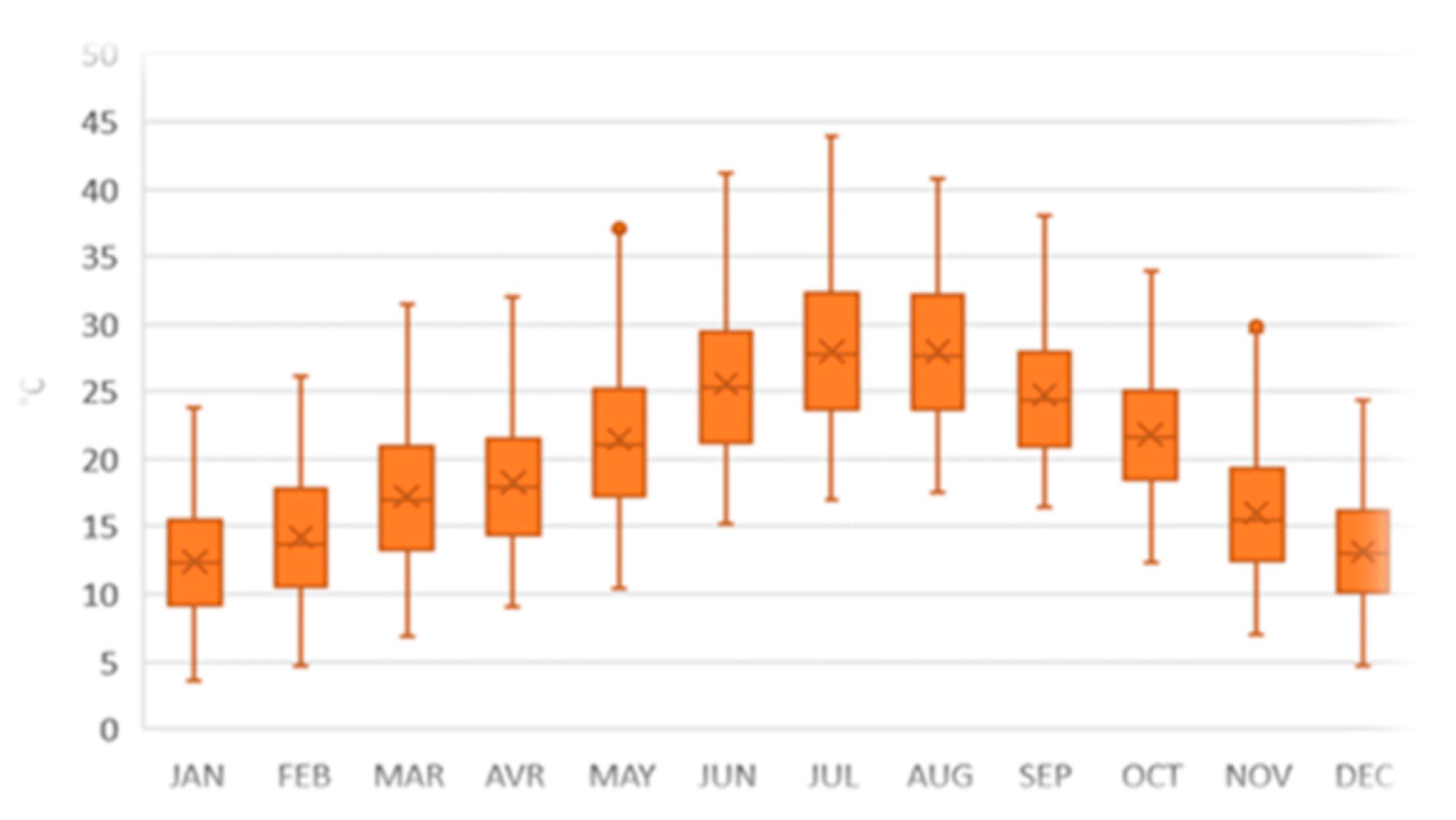
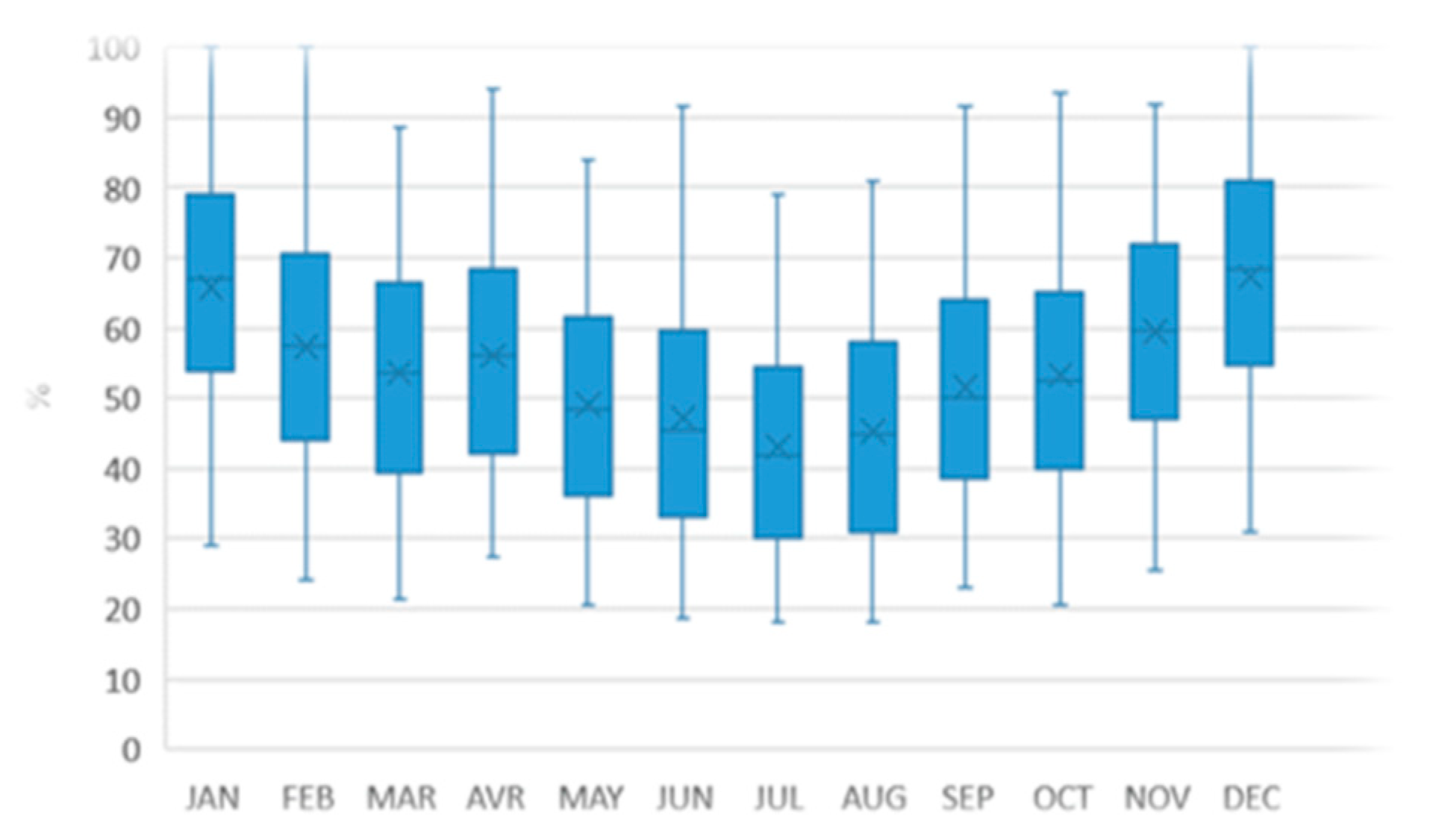

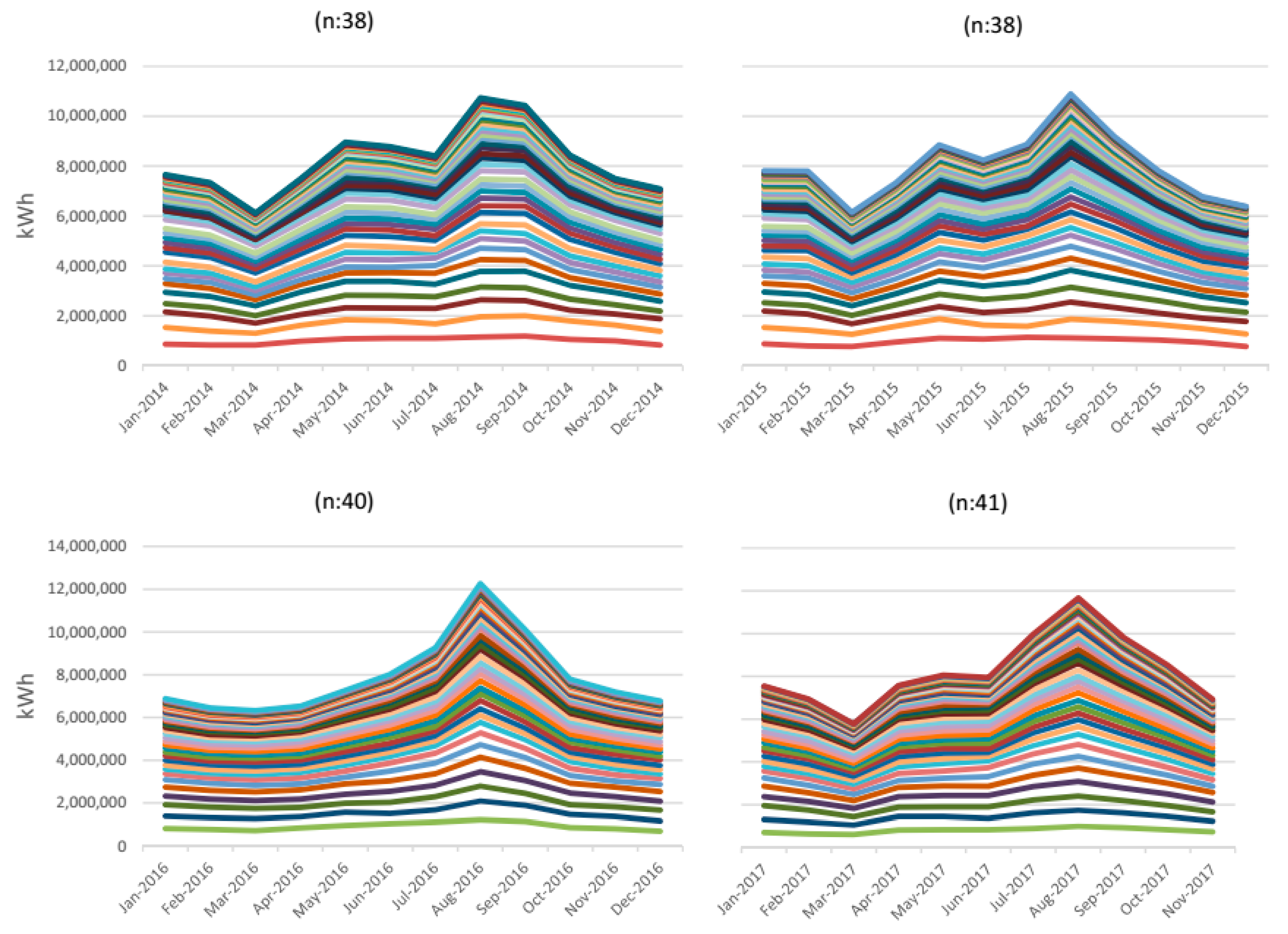
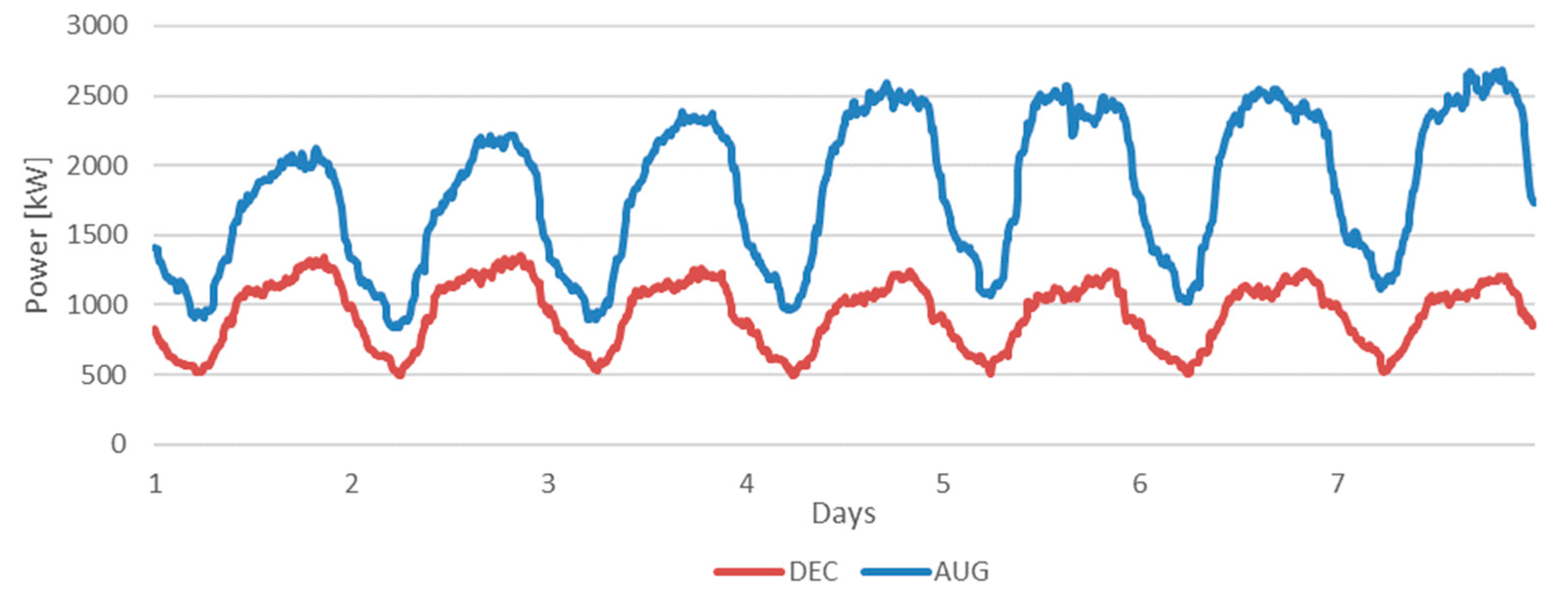
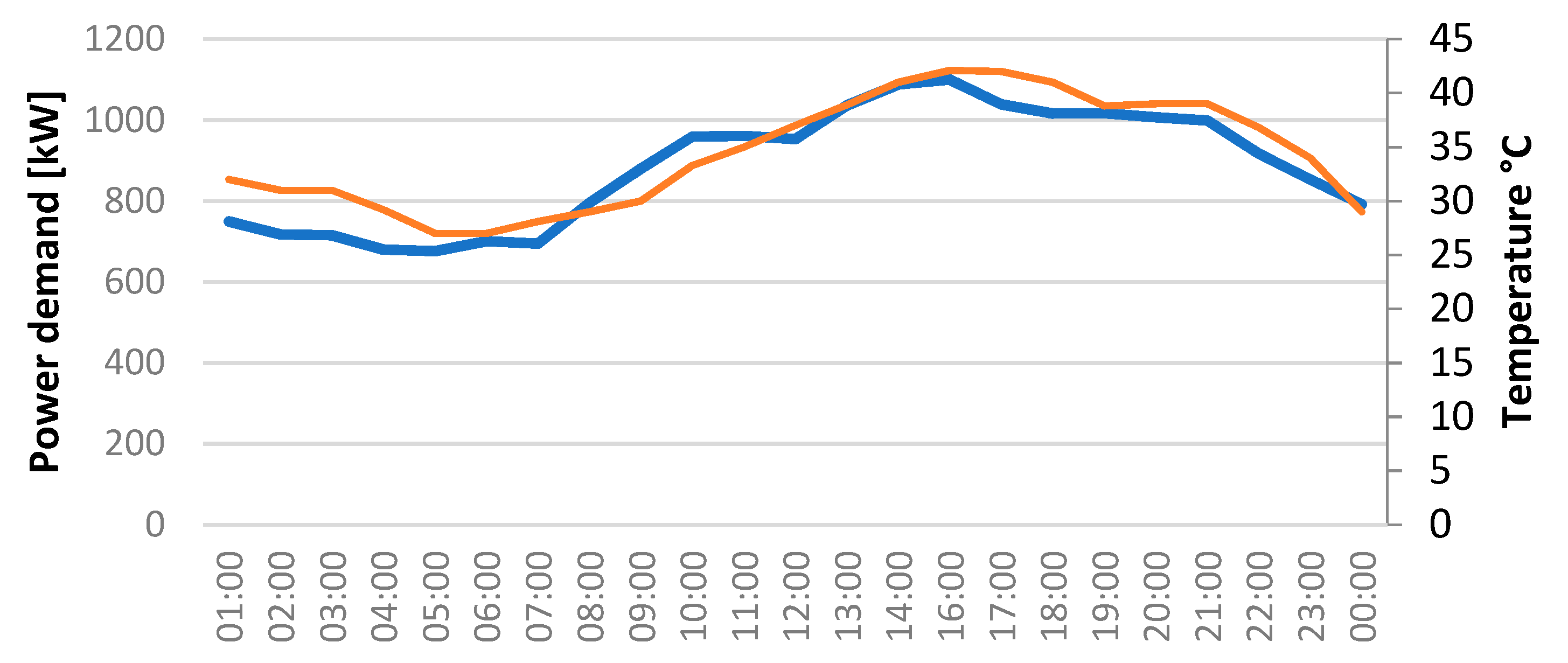
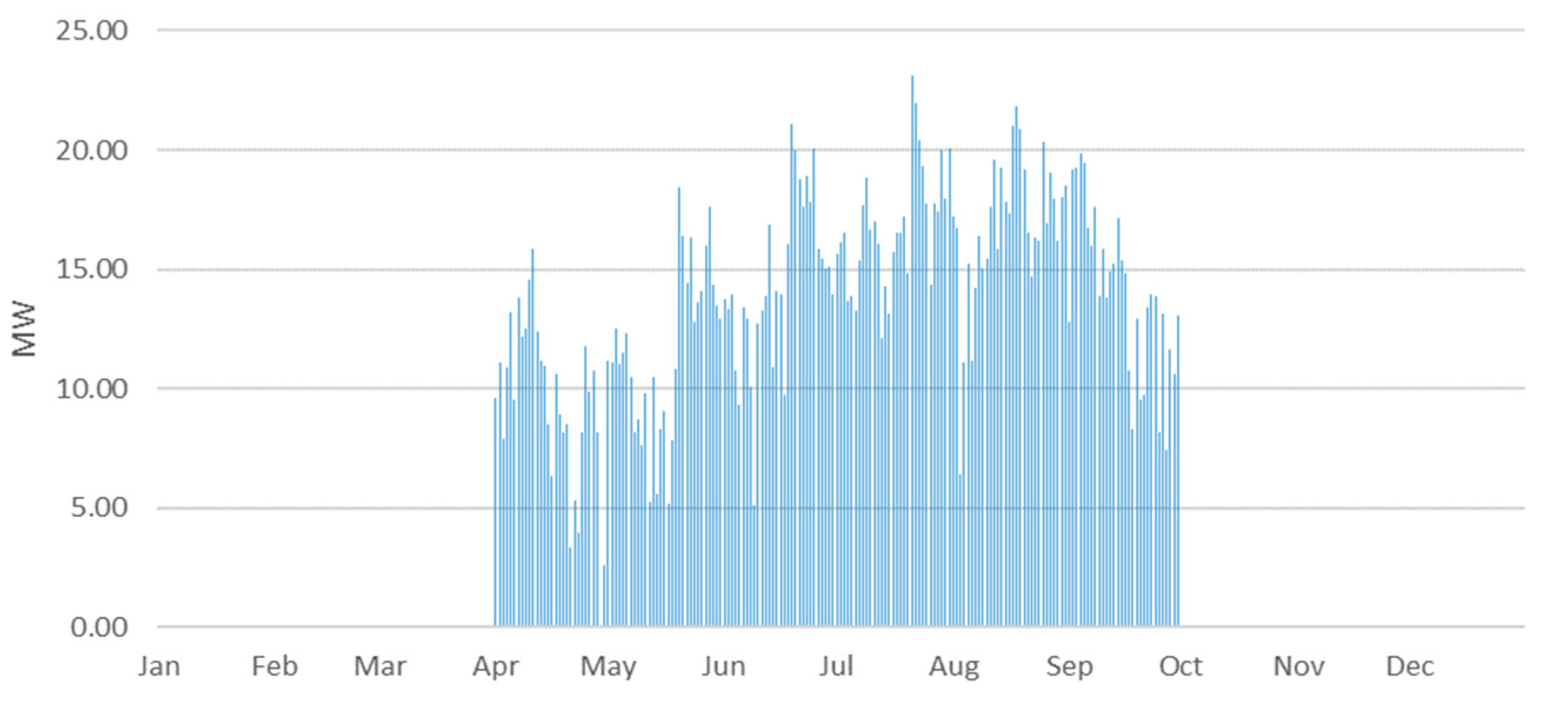
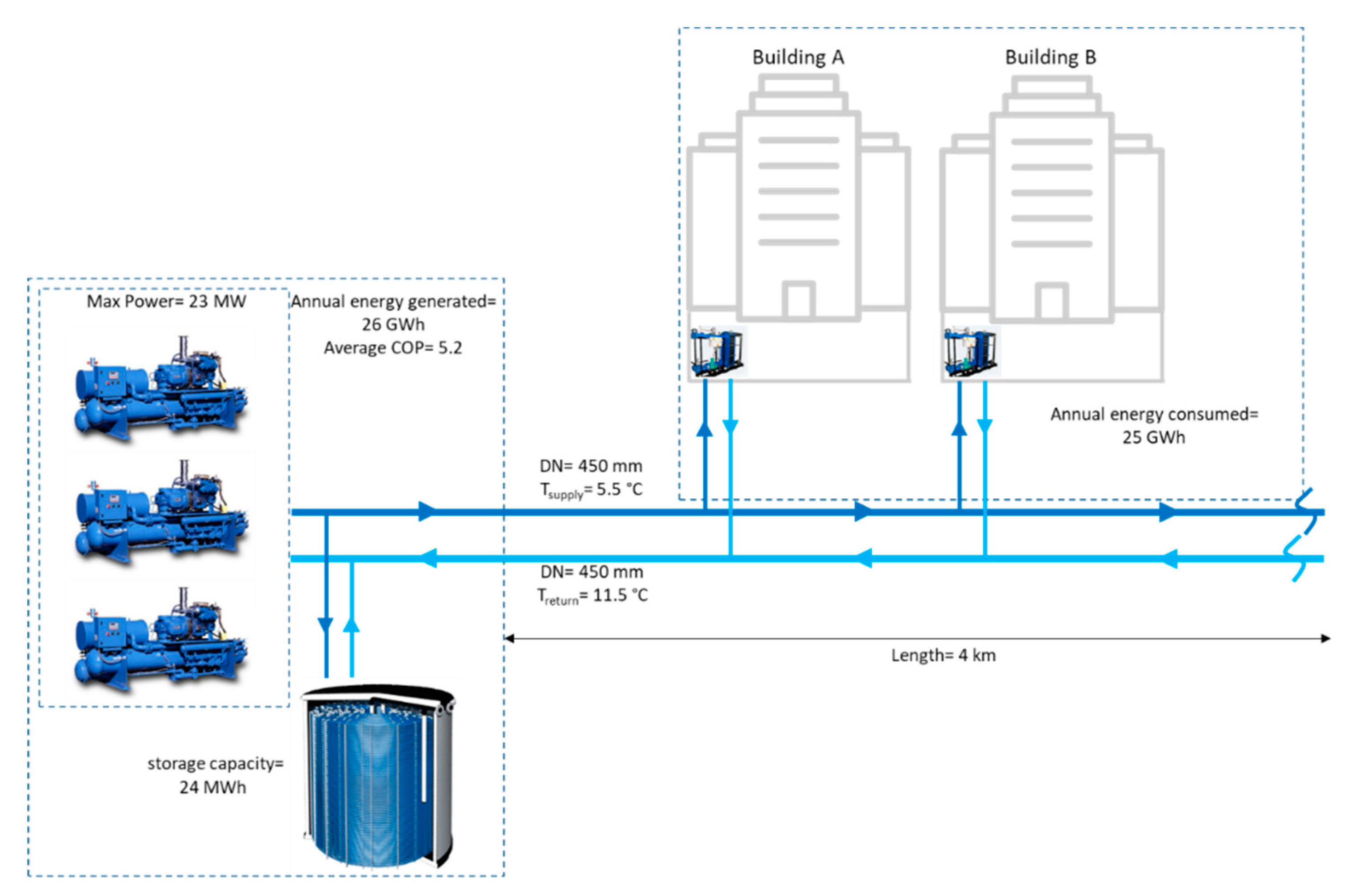
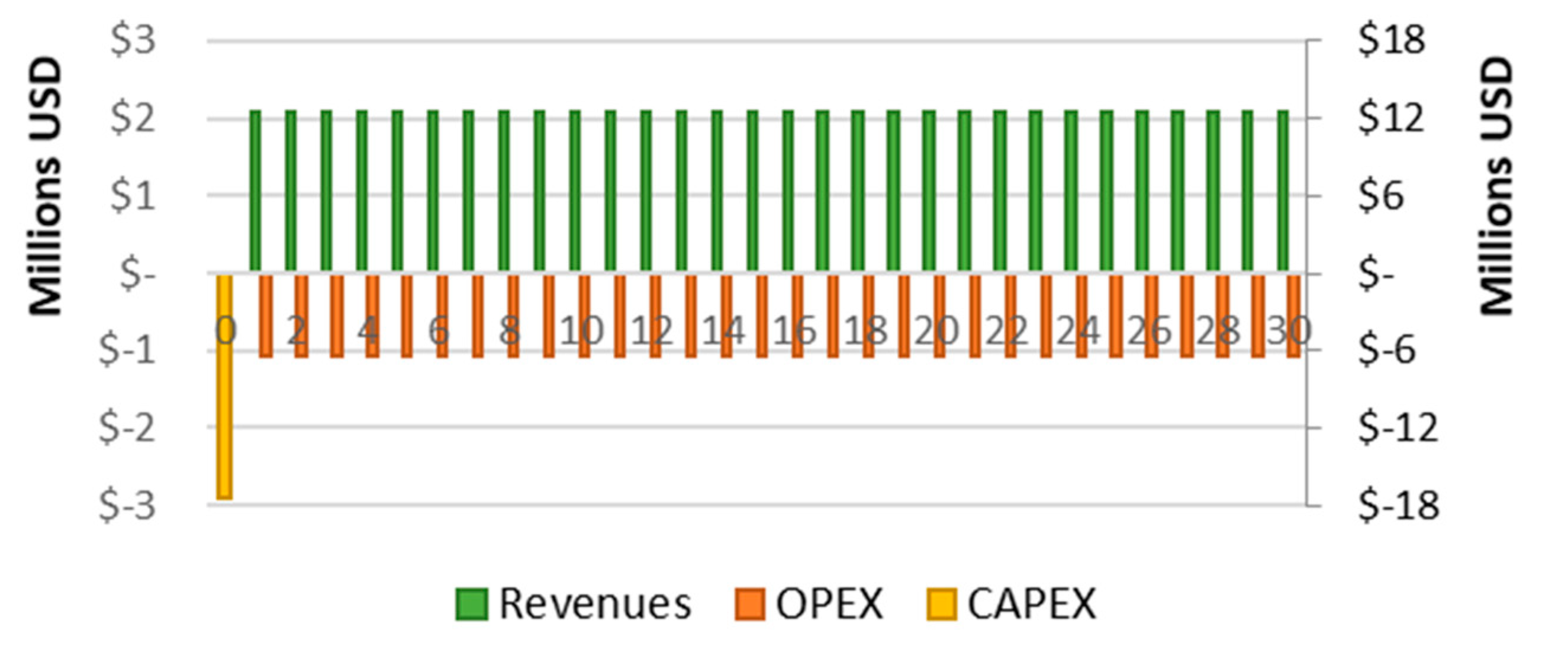
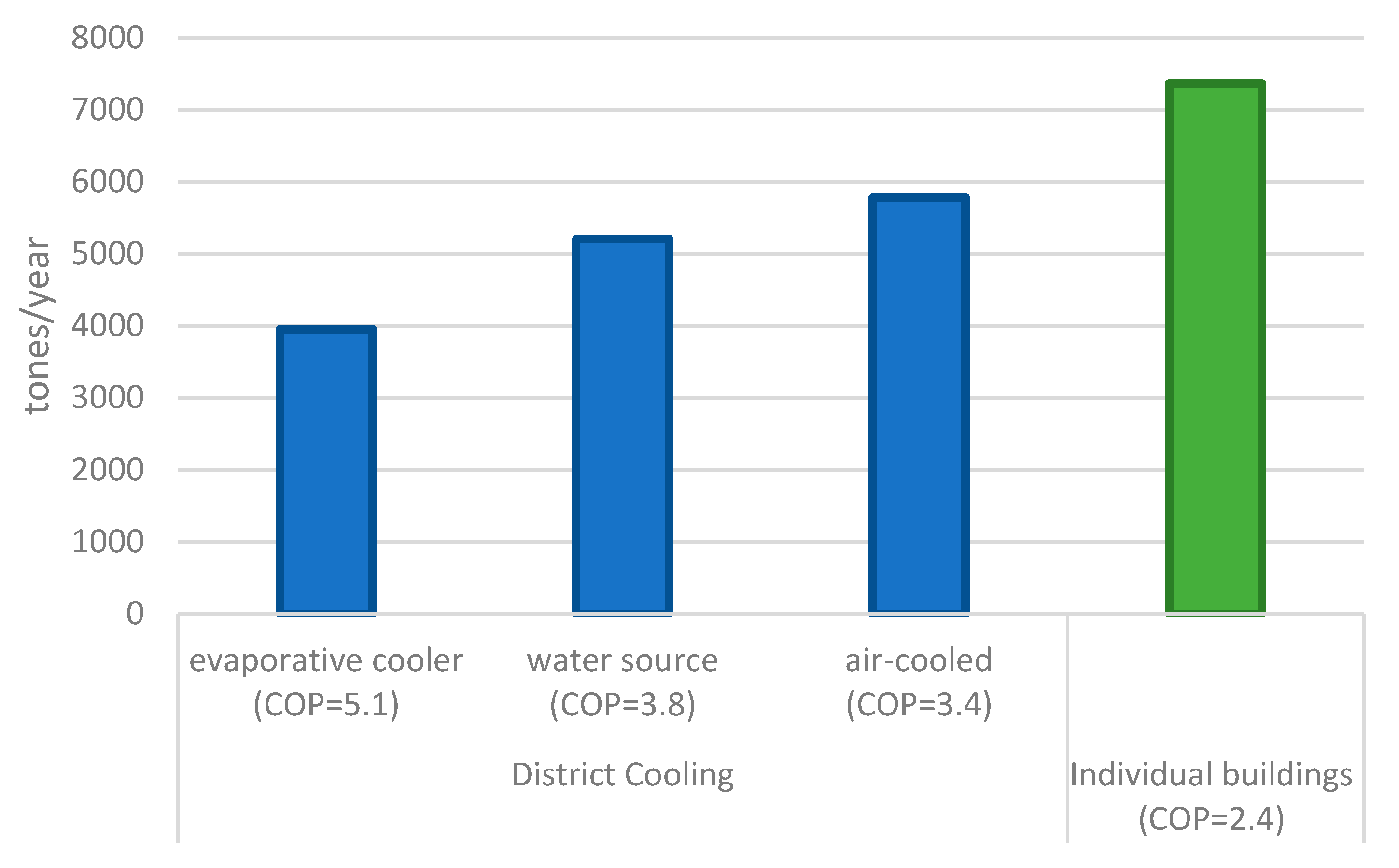
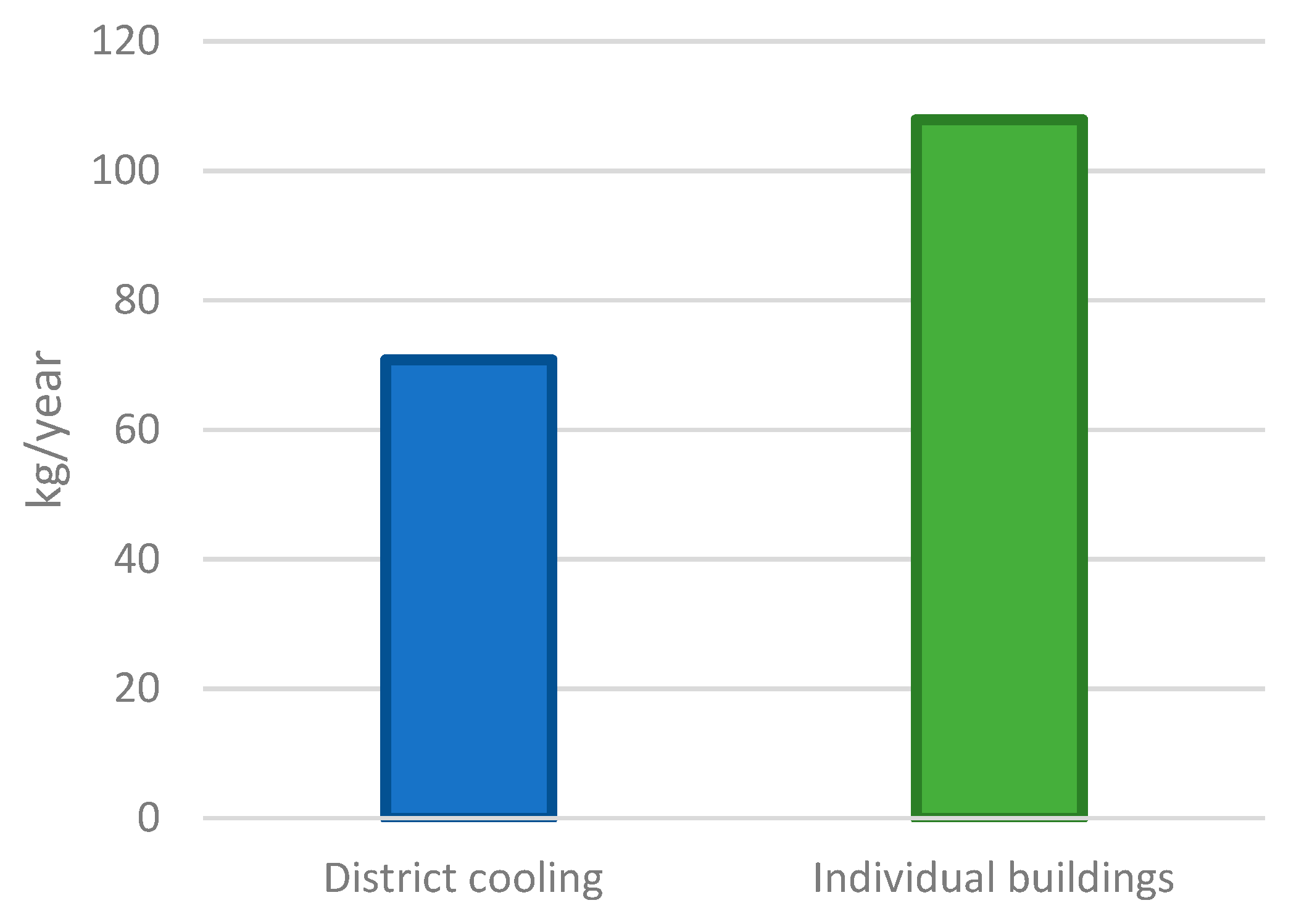
| City | Country | Starting Year | Technical Details |
|---|---|---|---|
| Paris | France | 1978 | Electrical chillers, river, geothermal and grey water heat pumps |
| Milan | Italy | 1997 | Electrical and absorption chillers |
| Vienna | Austria | 2009 | Absorption, electrical chillers, river |
| Stockholm | Sweden | 1995 | Seawater, heat pumps, electrical chillers |
| Solna/Sundbyberg | Sweden | 1995 | Seawater, heat pumps, electrical chillers |
| Helsinki | Finland | 1998 | Seawater, absorption, heat pumps, electrical chillers |
| Vajo | Sweden | 2011 | Absorption, electrical chillers, and lake |
| Dubai | UAE | 2009 | Electrical chillers |
| Houston | USA | 1969 | Electrical and absorption chillers |
| 2014 | 2015 | 2016 | 2017 | |
|---|---|---|---|---|
| Ramadan | 28 June to 27 July | 18 June to 17 July | 6 June to 5 July | 27 May to 25 June |
| Scenario | Heat Rejection Component | Average Seasonal COP |
|---|---|---|
| Individual air-cooled | Dry cooler | 2.4 |
| DC air-cooled | Dry cooler | 3.4 |
| DC water-cooled | Evaporative cooler (cooling tower) | 5.1 |
| Treated greywater | 3.8 |
| Net Present Value (USD) | PBT (years) | IRR (30 years) | ROI |
|---|---|---|---|
| 3,822,353 | 23 | 4.1% | 21.9% |
© 2019 by the authors. Licensee MDPI, Basel, Switzerland. This article is an open access article distributed under the terms and conditions of the Creative Commons Attribution (CC BY) license (http://creativecommons.org/licenses/by/4.0/).
Share and Cite
Charani Shandiz, S.; Denarie, A.; Cassetti, G.; Calderoni, M.; Frein, A.; Motta, M. A Simplified Methodology for Existing Tertiary Buildings’ Cooling Energy Need Estimation at District Level: A Feasibility Study of a District Cooling System in Marrakech. Energies 2019, 12, 944. https://doi.org/10.3390/en12050944
Charani Shandiz S, Denarie A, Cassetti G, Calderoni M, Frein A, Motta M. A Simplified Methodology for Existing Tertiary Buildings’ Cooling Energy Need Estimation at District Level: A Feasibility Study of a District Cooling System in Marrakech. Energies. 2019; 12(5):944. https://doi.org/10.3390/en12050944
Chicago/Turabian StyleCharani Shandiz, Saeid, Alice Denarie, Gabriele Cassetti, Marco Calderoni, Antoine Frein, and Mario Motta. 2019. "A Simplified Methodology for Existing Tertiary Buildings’ Cooling Energy Need Estimation at District Level: A Feasibility Study of a District Cooling System in Marrakech" Energies 12, no. 5: 944. https://doi.org/10.3390/en12050944





